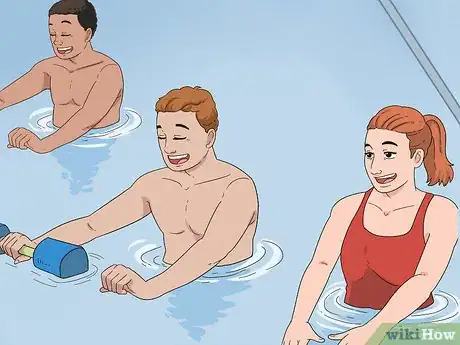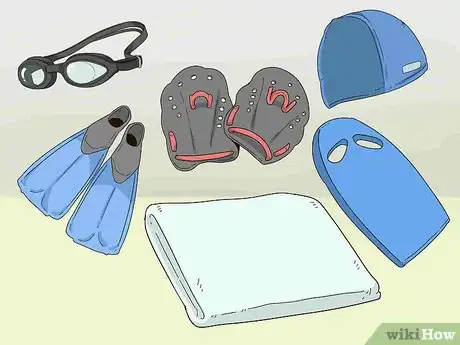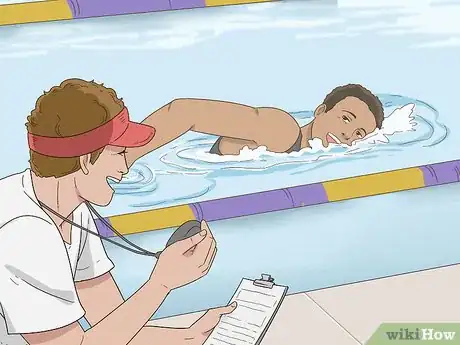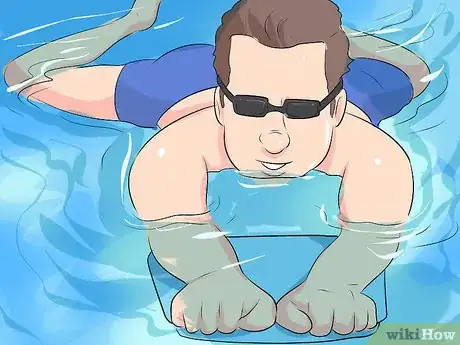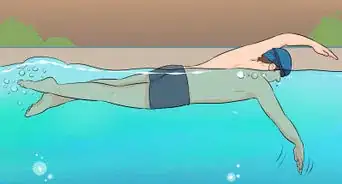This article was co-authored by Francisco Gomez and by wikiHow staff writer, Jennifer Mueller, JD. Francisco Gomez is the Head Coach at the FIT Potato Gym, a training gym established in 2001 in the San Francisco Bay Area. Francisco is a former competitive runner who helps endurance athletes train for major marathons like the Boston Marathon. Francisco specializes in Injury Rehab, Flexibility, Marathon Training, and Senior Fitness. He has a B.S. in Nutrition and Exercise Physiology & Running.
There are 11 references cited in this article, which can be found at the bottom of the page.
wikiHow marks an article as reader-approved once it receives enough positive feedback. In this case, 89% of readers who voted found the article helpful, earning it our reader-approved status.
This article has been viewed 389,339 times.
Swimming for fitness can improve your digestion and sleep patterns, lower your cholesterol levels, and keep you well toned. Swimming can also build strength and endurance, increase your circulation, and make you more flexible. Since water buoyancy is forgiving of weight, injury, or weakness, it's a low-impact exercise option for many different types of people. As long as you have relatively easy access to a pool or other swimming area, you can swim to stay fit.[1]
Steps
Choosing Your Strokes
-
1Start with the backstroke. With the backstroke you can breathe normally the whole time. Use this stroke to start, or if you want to take a break from the more technical breathing required for other strokes. The backstroke can improve your posture by extending your back and shoulder muscles.[2]
- Try to keep your body as flat as possible at the surface of the water. If you let your hips dip too far down, it can slow you down.
- The backstroke is more or less the same as freestyle, only you're laying on your back instead of on your stomach.
- When you swim the backstroke, you'll be looking at the ceiling the whole time. Identify markers that will let you know when you're near the end of your lane so you don't run into the wall.
-
2Switch to freestyle. The freestyle stroke is perhaps the most popular competitive swimming stroke, and it's good for stretching your entire body. You'll get a particularly good workout of your shoulders and back, biceps, triceps, quadriceps, glutes, and hamstrings.[3]
- To swim freestyle, you'll be on your stomach in the water. Push off from the wall and extend your arms straight out in front of you. You'll pull your body forward with your arms by lowering one arm at a time deep into the water and circling it back around when it reaches the outside of your thigh.
- As you're bringing one arm up, push the other arm down to repeat the motion. Rotate your body with the stroke.
- Do flutter kicks with your legs to help propel your body forward. You may want to practice your flutter kicks while holding on to the wall.
Advertisement -
3Move on to the breaststroke. While the breaststroke can be technically difficult to perform well, it can be a relaxing stroke because you can better control the pace. It provides the same whole-body benefits as freestyle, and can be a good stroke to alternate for slower laps.[4]
- For the breaststroke, move both of your arms at the same time. Start on your stomach on the water with your arms out in front of you. Starting at your chin, push your palms forward, out, and down, keeping your hands in front of your shoulders at all times. Keep your hands in a spear-point shape. Continue the cycle, bringing your hands out of the water and then back down again.
- For the breaststroke kick, bring your knees together and tuck them in towards your body, then push them out, kicking your feet out in a circular motion – out, and then coming back together again.
- Coordinate your arms and legs so that you're kicking out as your arms are up out of the water, and tucking your knees in as you push your hands down into the water.
- The breaststroke may exacerbate existing neck, back, or knee injuries. If these areas are an issue for you, talk to your health care provider before you start doing the breaststroke.
-
4Challenge yourself with the butterfly stroke. The butterfly stroke is a difficult stroke to pull off technically, and exhausting to maintain physically. But if you are swimming several different strokes, it can provide a break from the monotony.[5]
- Pull your arms forward, out, and then down to form a "Y" shape in front of your body. Push them down and back along the sides of your body and then shove them forward to start the stroke again. These movements should be powerful, using your full range of motion.
- To kick, keep your legs, knees, and feet together like a dolphin tail. Break the surface of the water with your heels and the soles of your feet, then push your feet down against the water to propel yourself forward.
- The butterfly stroke is a real calorie burner that can help you burn as many as 800 calories in an hour.[6]
-
5Improve your kicks with kick board laps. If you need to improve the efficiency or power of your kicks, kick board laps allow you to focus on your kick strokes without worrying about your arms.[7]
- You also can use kick board laps as a restful break between harder, faster swimming laps.
Establishing Your Fitness Routine
-
1Set your fitness goals.[8] The type of swimming you do to stay fit will depend on what you want to accomplish with your fitness routine. For most fitness swimmers, a combination of strokes is used to provide a full-body workout.[9]
- For example, if you want to lose weight, you'll want to focus on the strokes that you can perform well and for the longest period of time, so you can get the greatest fat-burning benefits out of your exercise sessions.
- Once you've identified your major goal or goals, break them down into small, reachable goals so you can constantly monitor your progress and get a continual sense of achievement.
-
2Search online for workout plans. Once you've gotten used to swimming regularly, you'll get more out of each swimming session if you follow a specific plan rather than simply lapping up and down the pool without focus.[10]
- Check swimming sites online, such as the U.S. Masters Swimming Program at usms.org, or the England Masters at swimming.org. You'll find various swimming plans tailored to achieving particular fitness goals, as well as tips on how to improve the efficiency of your stroke.
- Other fitness clubs or local swimming clubs may also publish swimming workout routines on their websites. Some pools also provide suggested workout programs on laminated sheets along the walls of the pool area or locker room.
-
3Join a class. Particularly if you're just getting started with swimming, you may benefit from the structure of a class and an instructor who can correct your form. There are a wide variety of classes available if you want to swim to stay fit.
- If you find the idea of swimming laps boring, you might enjoy a water aerobics class, or a different water exercise class.
- You also might choose different classes to meet your specific fitness goals. For example, if you want to improve your flexibility, you might try a water yoga class.
-
4Swim consistently. You'll only see overall fitness benefits if you swim on a regular basis. Ideally, try to swim at least two or three times a week.[11] Even if you can only swim once a week, you'll still improve your fitness provided you're keeping active in other ways.[12]
- If you've just started, even those first few laps may prove more difficult than you anticipated. Just keep with it. Aim to increase the amount of time you swim with each visit.
- For example, your first few swims you may only be able to swim for 10 minutes. After a few 10-minute swims, increase your time to 15 minutes. The next week, increase your time again until you've built up to 45- or 60-minute swims.
-
5Vary your routine. Even if you're a proficient swimmer, you should include other types of exercise besides just swimming laps. If you want to keep your workout in the water, consider taking a water aerobics class. As you get more comfortable swimming, try increasing your time or distance.[13]
- Variety is important when swimming laps as well. Sticking to a single stroke can get boring after awhile, which can make it difficult to stay motivated and stick with your fitness routine.
- It also can be beneficial to supplement your swimming workouts with strength training workouts to help build your muscles. Focus on exercises that build the muscles you use the most when swimming, such as your shoulders, arms, and legs.
-
6Join forces with a buddy. Rather than going it alone, getting a swim coach or swimming with a friend or family member can help you stay motivated. If you enjoy a little friendly competition, you can race each other or compete for most laps or fastest overall time.
- You also may be less inclined to skip swimming sessions if there's another person involved who is counting on you to show up and help keep you honest.
-
7Do a dry-land warm up before you swim. Before you jump into the pool, spend a little time warming up your arms and legs. Do repetitive movements that utilize the full range of movements in your arms and legs for five to ten minutes.[14]
-
8Include a cool-down at the end of each swim. As with any exercise, you want to start your swimming session with a warm-up and end it with a cool-down to give your body a chance to readjust to its pre-exercise state.[15]
- With a swimming workout, a few slow laps at the beginning and end of your session function perfectly well as a warm-up or a cool-down.
- You also may want to treat yourself to a hot tub or sauna if those are available where you swim. If your pool has a café, a healthy snack or protein shake after your swim can be invigorating and rewarding.
Getting Ready to Swim
-
1Scout out swimming locations. If you want to swim to stay fit, you first must find a pool that is convenient to you. Ideally, you want to find an indoor pool so you can continue your swimming regimen year round.[16]
- Find out what classes are available at the pool, as well as the cost to use the pool. These fees can add up, so ask if you can purchase a monthly or yearly membership that will give you unlimited access to the pool for less money.
- Carefully inspect the pool and facilities. Ask staff about pool maintenance and make sure everything is kept clean and sanitary.
-
2Buy appropriate swimwear. One of the best parts about swimming to stay fit is that you typically don't need to invest in a lot of equipment to get started. However, you will need at least one swimsuit that is comfortable and functional for swimming.[17]
- If you're wearing a women's swimsuit, choose a one piece and move around in it to make sure it fits well and the straps won't slide off while you're swimming.
- Keep in mind that swimsuits stretch when they are wet, so be cautious about selecting a suit that is loose or stretchy.
- Polyester swimsuits hold up better in chlorinated water than suits made from other materials.
- If you're wearing men's swimming trunks, choose those that cling rather than board shorts or other loose, flappy shorts.
- You may want to cover more of your body for modesty reasons. Most pools allow full wetsuits that cover your arms and legs. Talk to the staff at the pool where you plan to swim so you can better understand your options.[18]
-
3Get other equipment if needed. At a minimum, you'll probably want to buy a pair of goggles to protect your eyes from the chlorine. If you have longer hair, you also may want to get a swim cap to keep your hair from getting in your way while you're swimming. Chlorine can also change or fade your hair color, so you may wish to wear a cap to protect your color.[19]
- Some pools may provide towels, but you may want to invest in a more super-absorbent towel for quick hops out of the pool for a water or bathroom break.
- Flippers or fins, hand paddles, and kick boards are swimming equipment used in perfecting your stroke or increasing your speed. Many pools loan these out for free or for a small rental charge. If you find you use these items regularly in your swimming routines, however, you may eventually want to buy your own.
- If you have a hard time keeping water out of your nose, consider buying nose plugs.
-
4Learn proper stroke techniques. If you've never taken formal swimming lessons before, or if you last took lessons as a small child, you might want to take some lessons before you start swimming for fitness.
- Working with a swim coach for your first few sessions will help you perfect your form and correct any bad habits you may have developed over the years.
- You also need to focus on your breathing technique. Incorrect breathing will sap your energy level and make your stroke less effective.
- Before you sign up for lessons, consider the type of training you are most interested in. Types of swim training include stroke development, training to improve starts and turns, sprinting, distance training, and open-water swimming.
-
5Enjoy yourself. If you find yourself getting stressed out or feeling pressured or intimidated by more serious swimmers, take a moment to remind yourself of your reasons for swimming. Focus on your own goals, and try not to compare yourself to other swimmers you may encounter. What’s most important is that you get what you want out of your swimming experience.
Expert Q&A
-
QuestionHow much do I have to swim if I want to get fit?
 Francisco GomezFrancisco Gomez is the Head Coach at the FIT Potato Gym, a training gym established in 2001 in the San Francisco Bay Area. Francisco is a former competitive runner who helps endurance athletes train for major marathons like the Boston Marathon. Francisco specializes in Injury Rehab, Flexibility, Marathon Training, and Senior Fitness. He has a B.S. in Nutrition and Exercise Physiology & Running.
Francisco GomezFrancisco Gomez is the Head Coach at the FIT Potato Gym, a training gym established in 2001 in the San Francisco Bay Area. Francisco is a former competitive runner who helps endurance athletes train for major marathons like the Boston Marathon. Francisco specializes in Injury Rehab, Flexibility, Marathon Training, and Senior Fitness. He has a B.S. in Nutrition and Exercise Physiology & Running.
Fitness Coach You should aim to swim at least 2 or 3 times per week so you can build your endurance and distance.
You should aim to swim at least 2 or 3 times per week so you can build your endurance and distance. -
QuestionIs swimming a good way to lose weight?
 Michele DolanMichele Dolan is a BCRPA certified Personal Trainer in British Columbia. She has been a personal trainer and fitness instructor since 2002.
Michele DolanMichele Dolan is a BCRPA certified Personal Trainer in British Columbia. She has been a personal trainer and fitness instructor since 2002.
Certified Fitness Trainer If your weight or size prevents you from exercising on land, swimming is a great way to burn calories which will help burn fat. A calorie reduced diet is even more important, though, so combine dietary changes with exercise to feel your best while losing weight.
If your weight or size prevents you from exercising on land, swimming is a great way to burn calories which will help burn fat. A calorie reduced diet is even more important, though, so combine dietary changes with exercise to feel your best while losing weight. -
QuestionHow can I rotate my body during swimming freestyle?
 Michele DolanMichele Dolan is a BCRPA certified Personal Trainer in British Columbia. She has been a personal trainer and fitness instructor since 2002.
Michele DolanMichele Dolan is a BCRPA certified Personal Trainer in British Columbia. She has been a personal trainer and fitness instructor since 2002.
Certified Fitness Trainer Keep your hips level, but when you reach forward, turn the shoulders so the recovery shoulder is down in the water and the shoulder on the arm that is pulling out and reaching forward is turned up out of the water.
Keep your hips level, but when you reach forward, turn the shoulders so the recovery shoulder is down in the water and the shoulder on the arm that is pulling out and reaching forward is turned up out of the water.
References
- ↑ https://swimoc.com/aquatic-exercise-understanding-the-lifelong-benefits-of-staying-fit-in-the-pool/
- ↑ http://www.swimming.org/masters/improving-your-backstroke-technique/
- ↑ http://www.netdoctor.co.uk/healthy-living/fitness/a5108/how-to-get-fit-swimming/
- ↑ http://www.netdoctor.co.uk/healthy-living/fitness/a5108/how-to-get-fit-swimming/
- ↑ http://www.swimming.org/masters/advanced-butterfly-stroke-technique/
- ↑ http://au.askmen.com/sports/bodybuilding_100/138_fitness_tip.html
- ↑ http://www.netdoctor.co.uk/healthy-living/fitness/a5108/how-to-get-fit-swimming/
- ↑ Francisco Gomez. Fitness Coach. Expert Interview. 24 October 2019.
- ↑ https://www.popsugar.com/fitness/Swimming-Interval-Workout-3535207
- ↑ http://www.netdoctor.co.uk/healthy-living/fitness/a5108/how-to-get-fit-swimming/
- ↑ Francisco Gomez. Fitness Coach. Expert Interview. 24 October 2019.
- ↑ http://www.netdoctor.co.uk/healthy-living/fitness/a5108/how-to-get-fit-swimming/
- ↑ Francisco Gomez. Fitness Coach. Expert Interview. 24 October 2019.
- ↑ http://www.activekids.com/swimming/articles/7-pre-swim-warm-up-movements
- ↑ https://www.popsugar.com/fitness/Swimming-Interval-Workout-3535207
- ↑ http://www.usms.org/articles/articledisplay.php?aid=1924&assoc=series
- ↑ http://www.usms.org/articles/articledisplay.php?aid=1925&assoc=series
- ↑ http://www.nhs.uk/Livewell/getting-started-guides/Pages/getting-started-swimming.aspx
- ↑ http://www.usms.org/articles/articledisplay.php?aid=1925&assoc=series










